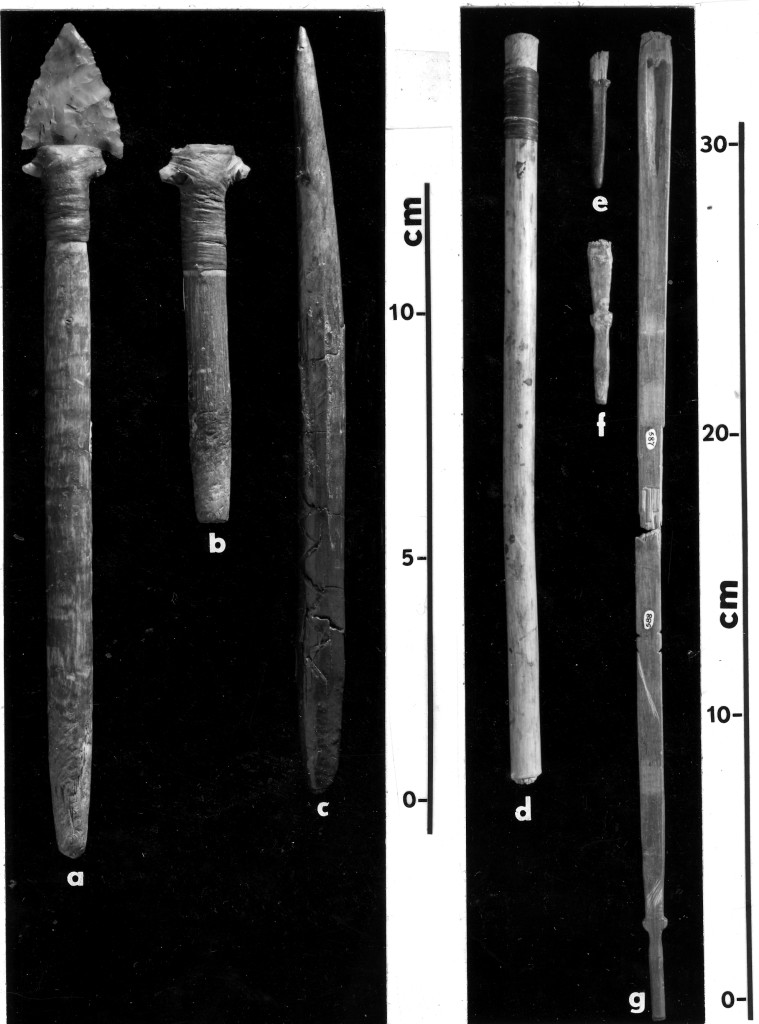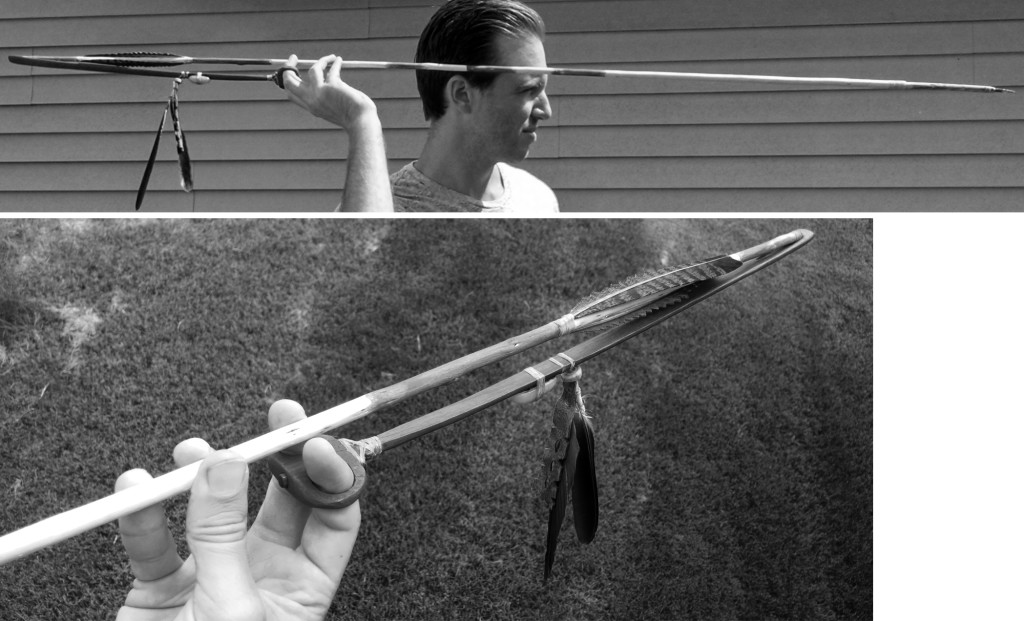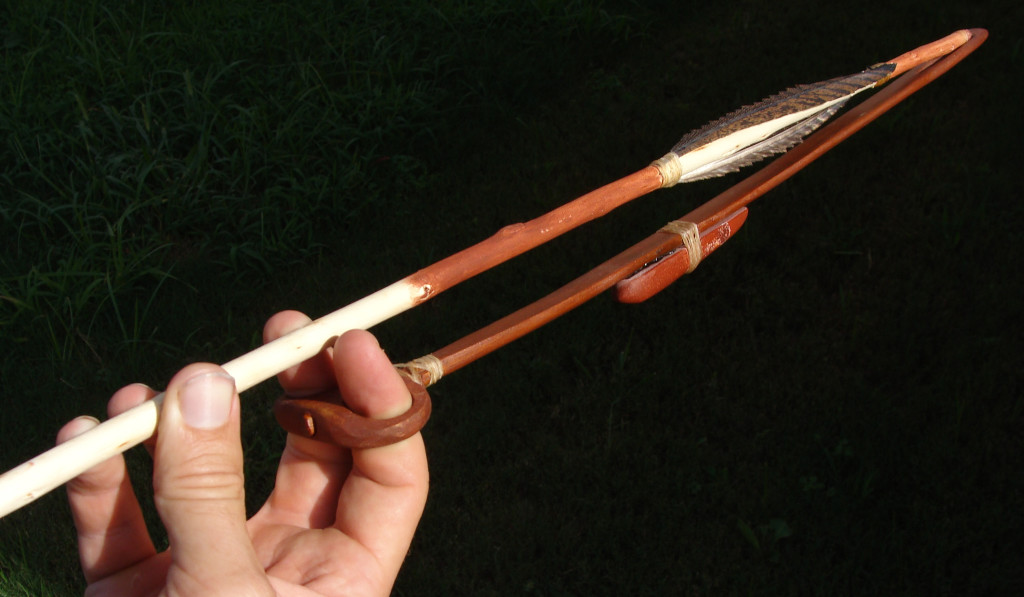Reproducing the Atlatl from Spring Creek Cave, Wyoming
By Devin B. Pettigrew and Justin Garnett
In The Atlatl, volume 27, number 2, pages 3-5
July 2014
The Spring Creek Cave atlatl is a small, curious device. The addition of some hypothetical attachments and a little experimenting could help explain the ancient weapons kit.
Setting: Spring Creek Cave is located high in the cliffs on the western edge of Wyoming’s Big Horn Mountains, in a narrow, environmental transition zone between the mountains and the Big Horn Basin to the west. Such ecotones provided a larger variety of animal and plant resources for ancient peoples than the neighboring environments. While the mountains are fairly gradual and receive more precipitation, the basin has been likened to an arid, Great Basin-like environment. Just a few kilometers to the south is Daugherty Cave (Frison 1968), which housed similar cultural deposits, while approximately 27 kilometers to the north is the Medicine Lodge Creek site, with extensive occupation and impressive rock art. (A visit to the latter is recommended.) Spring Creek and Daugherty Caves are suggested to have been seasonal campsites for mobile hunters.
Spring Creek Cave (SCC) was excavated by George Frison and crew in the 1950’s (Frison 1965). The cave yielded a number of atlatl and dart artifacts, including 4 proximal (handle end) fragments, but only one distal fragment, which matched one of the proximal fragments to represent a nearly whole atlatl shaft. The wood of the atlatl was well-worked, painted with ochre and polished. While the SCC atlatl has many aspects of Basketmaker II atlatls from the Southwest—in the plano-convex shaft, square distal end, short loading groove and raised spur—it may also have characteristics of atlatls from the northern Great Basin and Northern Plains. Current research in Wyoming archaeology suggests a period of higher activity in the Bighorn Basin during the Late Plains Archaic (2000-1500 BP), with the construction of pit-houses and a greater reliance on edible plants; similar to cultural remains from the Great Basin (Kornfeld et al. 2010:125-129). However, linkages with the Northern Plains are also suggested. Fittingly, artifacts from the Black Hills may represent the same weapon tradition (Weathermon 2010).
Bison bones make up the primary faunal deposits in SCC, with lesser numbers of antelope, sheep and deer. Hunters were likely taking advantage of game trails leading to isolated water resources in the mountains. Frison says of the whole atlatl from SCC: Numerous people, avocational and professional archaeologists alike, questioned that an atlatl I recovered from a dry cave in the Big Horn Mountains of northern Wyoming was well enough designed and large enough to be effective on animals the size of deer and pronghorn, let alone bison. However, the one nearly complete specimen and the parts of three others were of similar dimensions, suggesting a commonly used weaponry type rather than an aberrant one (2004:209).

Atlatl artifacts from Spring Creek Cave. Image courtesy of the Paleo-Indian Research Lab at the University of Wyoming.
Experimental Reproduction: Both authors of this article have independently produced replicas of the SCC atlatl and thrown with them over a period of some years. Dimensional replicas have been produced and tested in a number of woods, including bush honeysuckle (Lonicera spp.), coyote willow (Salix exigua), Osage orange (Maclura pomifera) and white ash (Fraxinus americana); as well as skunkbrush (Rhus trilobata), the presumed material of the original. While one might imagine this slight atlatl would be best paired with abnormally light darts, this is not the case. Replicas throw well with darts of average Basketmaker II dimensions, and dart fragments from the caves are of similar materials and dimensions. Darts tested weighed between 30 to 85 gr, and most test throwing was done with willow darts weighing approximately 70 gr.
Presumably the artifact originally had no lower handle, simply a set of fingerloops affixed to lugs set above a tapered shaft at the proximal end. As a result of this handle-less condition, a very snappy throw is required, as levering from the wrist is difficult without a lower handle. To throw, the index and middle fingers are placed through the loops and the dart shaft is gripped between the middle, ring, and pinky fingers and the thumb. The actual throw is a fast, snappy motion terminating in the rapid closing of the hand, which swings the atlatl over quickly and enables a clean release. Dart velocity does not appear to be reduced relative to more “conventional” assemblages. This throw feels awkward at first, as it is quite different than most throwers are used to, but practice will allow one to get the hang of it rather quickly.
Hard finger loops seem to work best on the test replicas, as they enable a more solid connection between the fingers and the atlatl. Softer hide loops allow greater “play” in the system, and have a less responsive “feel” in the cast. The best performing finger loops in testing have been wooden, with designs based on the McClure atlatl from Oregon, in which sheep horn loops were fitted to a peg at the proximal end (similar examples are the Quiltanton Lake atlatl from BC Canada, and the whale bone atlatls from the Par-Tee site on the Oregon coast; see Pettigrew and Whittaker 2012). Essentially “8” shaped pieces of wood were drilled between the finger holes to receive the tapered proximal end of the atlatl shaft. Hard plastic loops were also tested with good results, and presumably osseous materials would also work well. (Debris from working sheep and buffalo horn were common in the caves [George Frison, personal communication, 2012; Frison 1968]).

Reproduction of the Spring Creek atlatl with hypothetical hard loops, accessories and willow dart with chokecherry foreshaft.
Experimental testing has shown the atlatl from SCC not to be an ineffective or miniature weapon. By adopting a throwing form more centered on the shoulder and hand, this short and fragile appearing tool can be used to great effect with darts typical of Archaic calibers found elsewhere in North America. The result is a light weapons kit more convenient for foot travel over great distances. With that said, this type may have had certain limitations due to a combination of formal and material constraints. The originals were made of the heartwood of skunkbrush—by stripping off the sapwood in order to achieve the plano-convex shape. This wood is tougher than the limited selection of others in the basin, yet still not especially hard, nor does it grow to sufficient sizes for a wider shaft. The presence of several broken handle ends could indicate a weakness in the design. The five handles and only one distal fragment may also suggest that the broken atlatls were being brought back to camp for removal of “expensive” accouterments—especially finger loops.
More aspects to consider: ∙ A small 3cm long oval patch of resin on the bottom face below the double notches may indicate the attachment of a small weight or charm stone, as elsewhere in the arid West resin was used to aid weight attachment. Possible belemnite, calcite and steatite atlatl weights were found in the caves. ∙ The double notch set may have been the location of a decoration or fetish, as were attached to some Western atlatls such as the Nine Mile Canyon atlatl with a deer tail attached above the weight, the Roaring Springs atlatls with feathered cords (see Pettigrew and Whittaker 2012), and hanging appendages in rock art (Whittaker et al. 2008). If the resin patch is incomplete, however, the notches may have been used to attach a longer weight (e.g. Kornfeld et al. 2010:Figure 8.7a, b). ∙ The distal end of the atlatl shows wear best reproduced by grinding the end of a replica made of skunkbrush against concrete and stone, indicating the atlatl may have seen an ulterior function as a grinding implement for pigment, plant fiber, etc. ∙ Finally, testing has included velocity measurements, which indicate that these calibers are comparable with approximately 50lb traditional bows (see Whittaker 2013). Their effectiveness against bison in conventional penetration/hemorrhage hunting scenarios is questionable, but we have plans to test this further.
To see the Spring Creek assemblage, visit the Washakie Museum in Worland, WY.
References:
Frison, George C.
2004 Survival by Hunting: Prehistoric human predators and animal prey. University of California Press, Berkeley.
1968 Daugherty Cave, Wyoming. Plains Anthropologist 13(42):253-295.
1965 Spring Creek Cave, Wyoming. American Antiquity 31(1):81-94.
Kornfeld, Marcel, George C. Frison, and Mary Lou Larson
2010 Prehistoric Hunter-Gatherers of the High Plains and Rockies. Left Coast Press, Walnut Creek, California.
Pettigrew, Devin B., John C. Whittaker
2012 North American Atlatl Artifact List. Electronic document, http://basketmakeratlatl.com/?page_id=373, accessed july 7, 2014.
Weathermon, Rick L.
2011 Late Archaic Hunter-Gatherer Perishable Technologies in the Black Hills: An Investigation of the Crystal Cave Location and its Culturally Modified Wood. Ph.D. dissertation in prep., Department of Anthropology, University of Wyoming, Laramie.
Whittaker, John C.
2013 Dart Speed Measurements. The Atlatl 26(11)9-12.
Whittaker, John C., Byl Bryce and Chuck LaRue
2008 Southwestern Rockart; Atlatl Hunting with the Basketmakers. The Atlatl 21(4):4-6.
Additional Information (8-14-2014)
Table 1. Dimensions of the Spring Creek Cave Atlatl
| Length: overall | 48.3* [centimeters] |
| of proximal fragment | 23.5 |
| of distal fragment | 23.3 |
| of spur | 0.4 |
| of loading groove | 5.5 |
| of ‘peg’ at proximal end | 4.2 |
| of lugs above peg | 0.4 |
| of resin patch on dorsal face, just proximal to edge notches | 3 |
| Width: of distal fragment, maximum | 1.7 |
| of proximal fragment, maximum | 1.3 |
| of ‘peg’ at proximal end | 0.6 |
| of loading groove | 0.9 |
| Thickness: of distal fragment | 0.4-0.8 |
| of proximal fragment | 0.4-0.6 |
| Distance: from spur tip to distal end | 1.7 |
| from proximal end to first set of edge notches | 17.6* |
| between edge notches | 0.7 |
The overall length is an estimate made by Weathermon (2010:307) given that a piece of shaft app. 1.5 cm long appears to be missing between the fragments. The distance from the proximal end to the first set of opposing edge notches was originally given as 11.5 cm, however this appears to be erroneous, and the approximation of 17.6 cm was made from the scaled image of the artifact. The rest of the measurements are taken from Frison 1965. The fragments are slightly concave on the ventral face and slightly convex on the dorsal face. The spur is carved in slight relief, giving the thickness of 0.8 cm at the distal end.
The dimensions for my best dart to throw with the reproduction (see image above) based on fragments from the caves are as follows: a coyote willow mainshaft 143.5 cm long, 0.7 cm diameter at proximal end to 1.2 cm diameter at distal end, with a choke cherry foreshaft 15 cm long. Fletchings are based on trimmed feathers (possible fletchings) from Spring Creek Cave.
The below image shows the atlatl refitted with a weight that is based on the one shown in Prehistoric Hunter-Gatherers of the High Plains and Rockies (Kornfeld et al. 2010:Figure 8.7a, b). This seems to make better sense, as the atlatl’s mass is increased, making for better balance with the dart (see Garnett 2011), and the break in the atlatl shaft also coincides with the distal end of the weight. It is unsurprising that the atlatl would break at a spot just above where it is supported by a weight. The dimensions for this weight are as follows: 8.5 cm long, 1.4 cm wide (the original is about 1.7 cm wide) and 1.2 cm tall.



